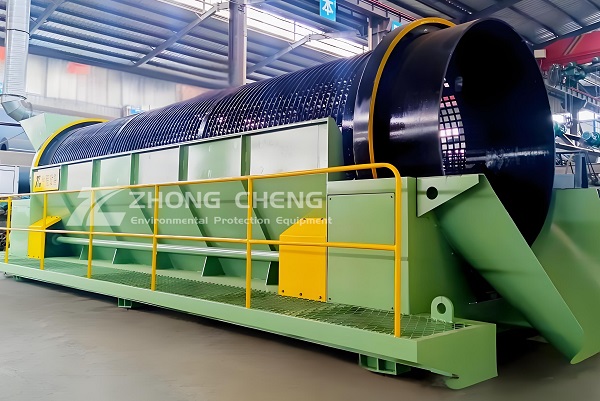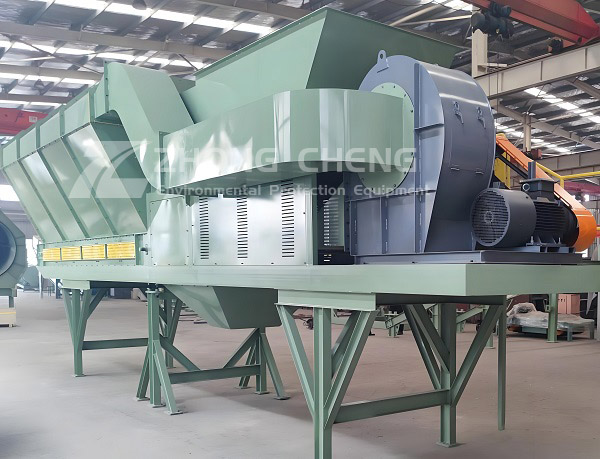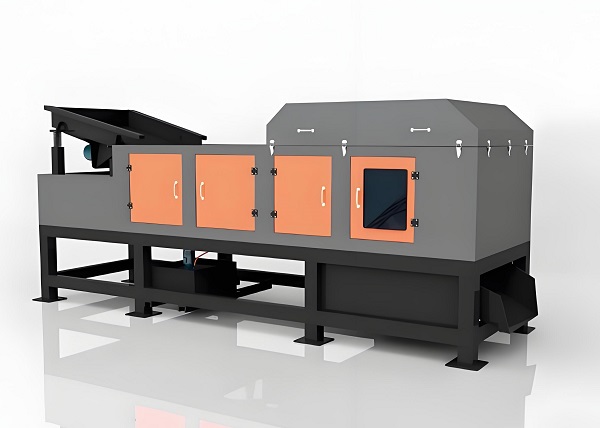Preface: With the acceleration of urbanization, the output of domestic garbage has increased dramatically, bringing huge challenges to urban management and environmental protection. As a key means to achieve garbage reduction, resource utilization and harmless treatment, garbage screening technology has developed rapidly in recent years. Below, the editor of Zhongcheng Machinery introduces the current status and future development trends of garbage screening technology, and provides reference for practice and research in related fields.
A. Current status of garbage screening technology

1. Technology type and application
Garbage screening technology mainly realizes automatic separation based on the differences in the physical properties of garbage, such as particle size, density, magnetism, etc. At present, common garbage screening equipment includes vibrating screens, drum screens, wind screens, etc. These devices divide garbage into multiple particle size levels through different screening mechanisms, which is convenient for subsequent resource utilization and harmless treatment.
The vibrating screen uses vibration to make the garbage jump and roll on the screen surface, thereby realizing the separation of garbage of different particle sizes. The drum screen classifies the garbage according to the particle size through the joint action of the rotating drum and the screen. The wind screen uses the action of airflow to separate light and heavy garbage.
With the development of intelligent technology, intelligent screening technology for domestic waste has gradually emerged. Intelligent screening technology integrates advanced sensor recognition, automatic control and efficient sorting technology, and can carry out fine processing of mixed garbage. Through AI image recognition, near-infrared spectral analysis and other technologies, the intelligent screening system can accurately identify various types of garbage materials, significantly improving sorting efficiency and purity.
2. Processing process and resource utilization
The garbage screening process usually includes pretreatment, multi-stage screening, wind separation and gravity separation, optical and intelligent separation, and organic matter treatment. The pretreatment stage mainly conducts preliminary screening of the collected domestic waste to remove large pieces of garbage and other items that are not suitable for entering the screening system. The multi-stage screening stage uses screens or drum screens with different apertures to divide the garbage into multiple particle size levels. The wind separation and gravity separation stage uses airflow and density differences to further separate the garbage. The optical and intelligent separation stage introduces advanced optical sorting machines and AI image recognition technology to accurately separate specific types of garbage. In the organic matter treatment stage, the screened organic waste is biologically treated and converted into organic fertilizer or biogas energy.
Through the garbage screening process, recyclables, kitchen waste, etc. can be separated and resource utilization can be realized. Recyclables such as plastics, paper, metals, etc. can be used to make new products after recycling. Organic waste such as kitchen waste can be converted into organic fertilizer or biogas energy through composting or anaerobic fermentation to promote resource recycling.
3. Policy support and market demand
In recent years, great attention has been paid to the treatment of urban domestic waste, and a series of policies have been introduced to support the development of garbage screening technology. These policies not only encourage relevant enterprises to develop and promote garbage screening technology, but also provide incentives such as financial support and tax incentives. With the implementation of the garbage classification system, the market demand for garbage screening technology is also growing. More and more cities have begun to pilot the application of garbage screening technology to improve garbage treatment efficiency and resource utilization. The public's awareness of garbage classification and environmental protection is also constantly improving, providing a good social atmosphere for the development of garbage screening technology.
B. Development trend of garbage screening technology

1. Intelligence and automation
With the development of technologies such as artificial intelligence and the Internet of Things, garbage screening equipment will become more intelligent and automated. The future garbage screening system will realize real-time monitoring and intelligent control of the garbage treatment process by integrating advanced sensors, controllers and actuators. Through the optimization and analysis of AI algorithms, the system can automatically adjust the operating parameters to adapt to the needs of different types of garbage treatment. This will greatly improve the efficiency and accuracy of garbage screening and reduce labor costs.
2. Efficiency and refinement
In order to improve the efficiency and resource utilization of garbage screening, the future garbage screening technology will pay more attention to efficiency and refinement. By improving the structure and process of screening equipment, the screening efficiency and purity can be improved. Introduce more sorting technologies and equipment, such as magnetic separation, photoelectric sorting, etc., to classify and treat garbage more finely. This will help to maximize the utilization and harmless treatment of garbage.
3. Diversification and resource utilization
The future garbage screening technology will pay more attention to diversification and resource utilization. By developing more screening equipment and processes, the screening and treatment of different types of garbage can be achieved. Strengthen the research on resource utilization of various types of screened garbage and convert them into valuable resources or energy. For example, process waste wood into biomass fuel or gardening cover; recycle metal fragments and use them to make new metal products. This will help promote the development of the circular economy and reduce the consumption of primary resources.
4. Environmental protection and standardization
With the improvement of environmental awareness and the improvement of laws and regulations, future garbage screening technology will pay more attention to environmental protection and standardization. Reduce environmental pollution in the process of garbage disposal by adopting a fully enclosed working environment, efficient dust removal and noise reduction measures. Formulate and improve relevant standards and specifications for garbage screening technology to ensure the reliability and safety of the technology. This will help promote the standardization and sustainable development of garbage screening technology.
C. Challenges and coping strategies

1. Technical challenges
Although garbage screening technology has made significant progress, it still faces some technical challenges. For example, although intelligent screening technology can improve sorting efficiency and purity, it is costly and has high requirements for equipment. For some special types of garbage (such as garbage containing hazardous substances), current screening technology is still difficult to completely achieve harmless treatment.
In order to meet these technical challenges, it is necessary to increase R&D investment and promote technological innovation and upgrading. Strengthen exchanges and cooperation with international advanced technologies, introduce and digest and absorb advanced technological achievements, and improve the overall level of garbage screening technology.
2. Funding challenges
The promotion and application of garbage screening technology requires a lot of capital investment. However, at present, governments and enterprises in some regions have insufficient investment in garbage screening technology, resulting in limited technology application. Due to the long investment return cycle of garbage screening technology, some companies are not willing to invest in it.
In order to meet the funding challenges, the government needs to increase its support and provide incentives such as financial support and tax incentives. Encourage social capital to participate in the research and development and promotion of garbage screening technology to form a diversified investment pattern. It is also possible to provide a stable source of funds for the promotion of garbage screening technology by establishing a garbage disposal fee system.
3. Social cognitive challenges
Although the public's awareness of garbage classification and environmental protection is constantly improving, some people still do not have a deep understanding of garbage screening technology. This has led to misunderstandings or resistance in garbage classification and treatment by some people, affecting the promotion and application of garbage screening technology.
In order to meet the challenges of social cognition, it is necessary to strengthen environmental education and publicity to improve the public's awareness and understanding of garbage screening technology. At the same time, through the display of demonstration projects and successful cases, the public's confidence and trust in garbage screening technology can be enhanced. A public participation mechanism can also be established to encourage the public to actively participate in garbage sorting and treatment, and jointly promote the development and application of garbage screening technology.
PS: As a key means to achieve garbage reduction, resource utilization and harmless treatment, garbage screening technology has made significant progress in recent years. Through continuous improvement and innovation, garbage screening technology has been able to achieve accurate classification and treatment of different types of garbage. At the same time, with the development of technologies such as intelligence and automation, garbage screening equipment will be more efficient, sophisticated and environmentally friendly. The development of garbage screening technology still faces some challenges, such as high technical costs, insufficient capital investment and insufficient social awareness. In order to meet these challenges, the government, enterprises and all sectors of society need to work together to increase R&D investment, provide financial support and strengthen environmental education. With the continuous advancement of technology and the continued attention of society, garbage screening technology will usher in a broader development prospect. By promoting technological innovation and industrial upgrading and strengthening international cooperation and exchanges, we have reason to believe that mankind will be able to better solve the problem of garbage disposal and achieve harmonious coexistence between man and nature.
Save Time! Get A Detailed Quotation Quickly.
